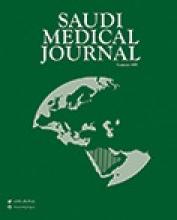Abstract
OBJECTIVE: This is a retrospective analysis of the clinical and laboratory features of 17 cases of factor XIII deficiency that were followed in tertiary care hospitals in Riyadh, Kingdom of Saudi Arabia, over 20 years. Cases were referred to these hospitals from other health care centers in the country.
METHODS: We performed a retrospective analysis of 17 cases of factor XIII deficiency comprising 11 males and 6 females, who were seen over a period of 20 years (1978-1998) in Riyadh, Kingdom of Saudi Arabia. Data variables including age, sex, origin, clinical presentation, bleeding time, prothrombin time, partial thromboplastin time, factor XIII screening and assay, hemoglobin, and platelet count were collected and analyzed. The diagnosis of factor XIII deficiency was made by urea clot lysis test alone in one patient and urea clot lysis test in combination with factor XIII quantitative assay in 16 patients.
RESULTS: Eleven patients were males and 6 were females. Median age at the time of diagnosis was 9 years (3-29 years). Ten patients (59%) had a family history of excessive bleeding. Presenting symptoms included ecchymosis and recurrent hematomas in 12 patients (71%), bleeding after circumcision in 6 male patients (55%), umbilical stump bleeding in 7 (41%), poor wound healing and keloids in 3 patients (18%), and intracranial bleeding in 3 patients (18%). Other manifestations included cephalohematoma, abortion, abruptio placenta, and intraperitoneal bleeding (one patient each). Laboratory evaluation revealed a normal prothrombin time, partial thromboplastin time, bleeding time and platelet count in all patients. Factor XIII screening test was positive in all 17 patients tested and assay for factors XIII was <0.06 U/ml in 16 patients tested.
CONCLUSION: Our data confirms that factor XIII deficiency is a rare bleeding disorder characterized by variable bleeding manifestations but consistent laboratory findings. The occurrence of keloid in our patient group may reflect the poor quality of the clotting, associated with loss of tensile strength of fibrin polymers, caused by factor XIII deficiency and leading to abnormally large scar formation.
- Copyright: © Saudi Medical Journal
This is an open-access article distributed under the terms of the Creative Commons Attribution-Noncommercial-Share Alike 3.0 Unported, which permits unrestricted use, distribution, and reproduction in any medium, provided the original work is properly cited.






